06 – 20 DECEMBER 2022
By Dylan Vasapolli
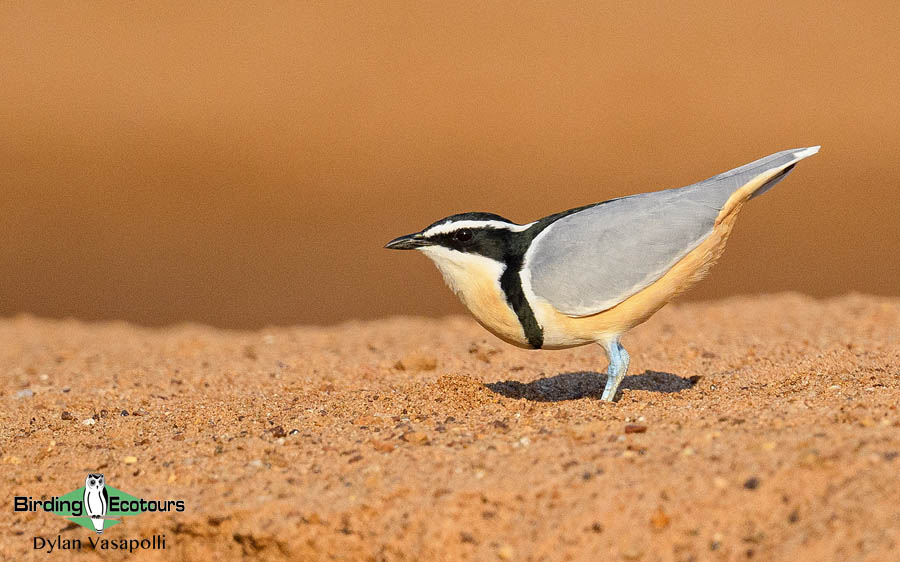
Egyptian Plover is a highly desireable species which showed extremely well on this tour!
Overview
This roughly two-week-long tour both began and ended in the tiny West African country of the Gambia, but was largely focused on Senegal, with almost all of the birding happening within Senegal. More specifically, this tour was designed to give us the best possible chances for many of the iconic Sahelian specials, like Quail-plover, Golden Nightjar, Cricket Warbler and Egyptian Plover, amongst others, while also trying for some local regional specials like White-crested Tiger Heron and enjoying the massive Scissor-tailed Kite roost in southern Senegal.
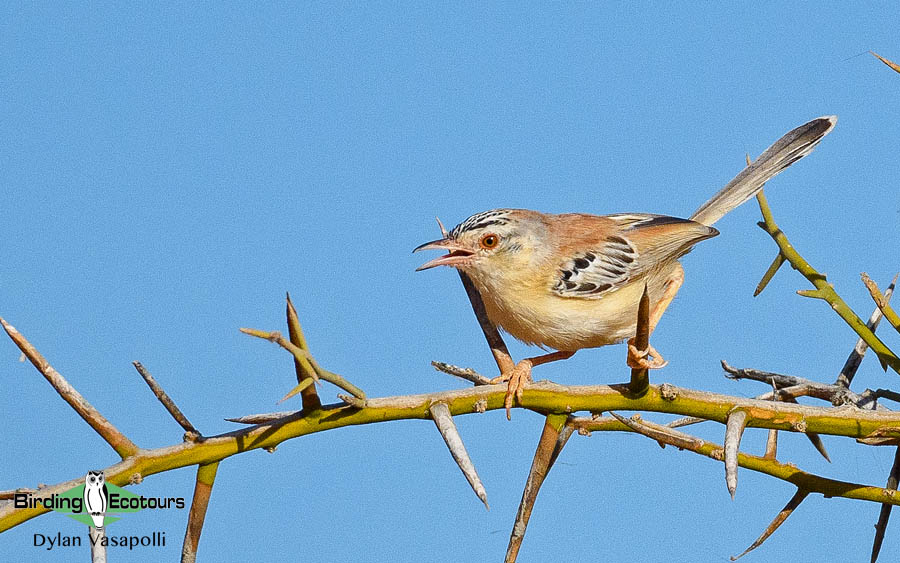
Cricket Warbler is a major special of the Sahel zone, occurring only in the far north of Senegal.
This tour took place at the start of the northern hemisphere’s winter and we experienced good, albeit, extremely warm conditions throughout the tour. Although the heat left us feeling tired occasionally, it had no impact on the birding opportunities throughout the tour. We did extremely well in finding almost all the route’s possible specials, with the only notable exception being Savile’s Bustard, which eluded us on numerous days. All the other hoped-for birds, like Quail-plover, Golden Nightjar, Cricket Warbler, River Prinia, Black Crowned Crane, White-crested Tiger Heron and Egyptian Plover showed well. Witnessing thousands of Scissor-tailed Kites coming in to their island roost in the early days of the tour was a major highlight. We also spent some time in the massive and relatively wild Niokolo-Koba National Park, and added several mammals to our list including an incredibly rare sighting of one of the last remaining ‘West African’ Lions. While we knew it was special, it was only after the fact that we realized just how special, with virtually no tourists having ever seen this almost extinct subspecies of Lion, and only a handful of researchers ever sighting it. One of our ultimate memories however, would be the fantastic boat trip conducted at the Wassadou Camp, where raptors, bee-eaters, kingfishers and bright Egyptian Plovers all took turns stealing the show.
The tour produced a good number of birds, with the total bird list reaching a little over 300 species, and was supplemented by several mammals as well. This was our first operated tour to this region, following a previous scouting tour, and sorting a few teething issues will allow us to run this tour even more smoothly in the coming years. A detailed daily account of the tour follows below, and the full species lists can be found at the end of the report.
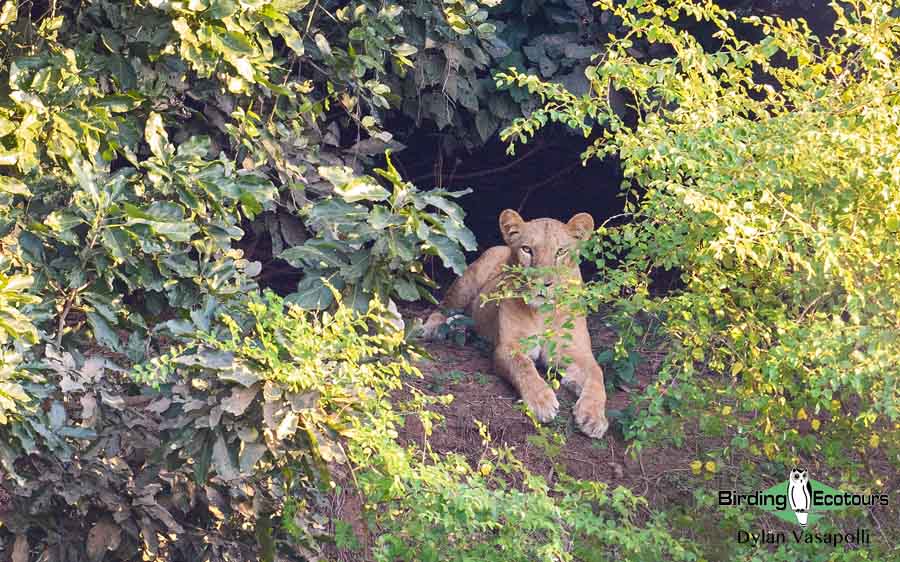
Seeing one of the last remaining wild ‘West African’ Lions was exceptional and a true privilege. This specific subspecies of Lion is on the edge of extinction, with fewer than 200 individuals thought to occupy parts of West Africa. Very little is known about this subspecies, including how widespread they are, and their exact population size. Very few sightings exist of these Lions, and even their dedicated researchers count themselves extremely fortunate to see them.
Detailed Report
Day 1, 06th December 2022. Arrival in Banjul, and transfer to Toubacouta
The tour started off leisurely, taking in the sights and sounds of the sprawling Senegambia Hotel, outside of Banjul, Gambia – with all the clients having arrived the previous evening. Here we got our first looks at species such as Western Plantain-eater, Green Wood Hoopoe, Western Red-billed Hornbill, Snowy-crowned Robin-Chat along with our first raptors, most notably Hooded Vulture and Grey Kestrel. After breakfast, we gathered our things and checked out, bound for the ferry that would take us across the Gambia River, and eventually into Senegal. Some stops were made along the way at some of the coastal wetlands, where we added a number of waterbirds to our list. Of special note were shorebirds including both Common Ringed and Little Ringed Plovers, Bar-tailed and Black-tailed Godwits, Red Knot, Ruff and Marsh Sandpiper. Good numbers of Western Reef Herons danced about in the shallows, whilst a few of the similar Black Heron also made an appearance. Larger waterbirds like Pink-backed Pelican and African Spoonbill were also present. The ferry trip across the river was enjoyable, and gave us views of both Parasitic and Pomarine Jaegers, along with the sought-after West African Crested Tern and a surprise Red-necked Falcon. Before long, we were at the Gambia-Senegal border, and after a bit of haggling, we were through and bound for the Saloum Delta at Toubacouta.
We checked into our perfectly suited lodge, before heading off on a boat trip out into the mangroves of the Saloum Delta. The rare White-crested Tiger Heronwas our primary target for the boat trip. We began our exploration by slowly working the quieter backwaters, carefully scanning the mangroves as we went along. Mudbanks on the river held an array of shorebirds, and here we added the likes of Eurasian Curlew and Common Redshank, along with Gull-billed Tern. Both Pied and Malachite Kingfishers obliged, as did the likes of Little and Blue-cheeked Bee-eaters. Various other waterbirds kept showing, like Hamerkop, but our main target remained elusive. A Beaudouin’s Snake Eagle showed well overhead as did groups of the bright Senegal Parrot, and we also found a big mixed roost of Black and Yellow-billed Kites. With the sun setting, we eventually had to make the call, and began making our way back, all the whilst, plotting our next plan of attack. With the dock in sight a short distance away, we couldn’t believe our luck when we spotted our quarry – a White-crested Tiger Heron perched in the open allowing everyone to take in its subtle beauty. With our first major target of the tour already under our belts, following an action-packed first day, we settled in for our first evening together!
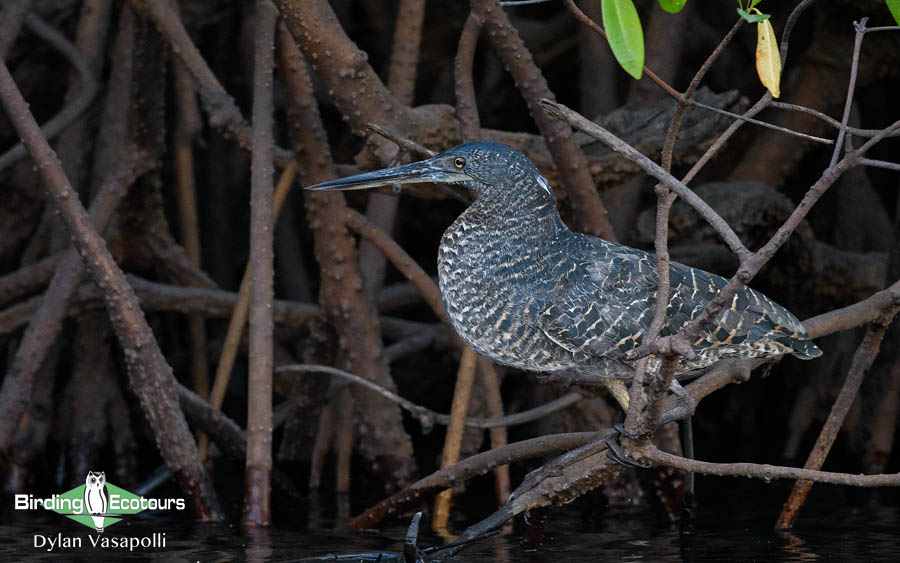
White-crested Tiger Heron is a rare species on the edge of its range in Senegal.
Day 2, 07th December 2022. Birding Toubacouta and surrounds
Our success of the previous day meant we could spend the day exploring the wooded area surrounding Toubacouta, searching for a different suite of birds. A short pre-breakfast morning walk got off to a good start, with a family of shy Stone Partridges calling from right outside our lodge. After a bit of searching, we were able to spot a few birds through the long grass. We also found more widespread species such as Senegal Coucal, African Grey Woodpecker and Northern Crombec. Resuming our birding after breakfast, we were in for a treat once again, with an excellent spell of birding. A group of Bearded Barbets showed well, feeding in a fruiting tree, before a pair of bright Yellow-crowned Gonoleks stole the limelight for a bit. A few Mottled Spinetails moved about overhead, and we also tracked down the likes of Black-billed Wood Dove, Swallow-tailed Bee-eater, Yellow-fronted Tinkerbird, Lavender Waxbill and a feisty Pearl-spotted Owlet. More open areas produced our first Senegal Thick-knees, along with Piapiacs, Anteater Chats, Village Indigobirds and several stunning Abyssinian Rollers. A group of Patas Monkeys were a surprising sight and a welcome distraction from the birding. With the heat rising, the bird activity quietened down and a few raptors were noted overhead – Osprey, African Harrier-Hawk, Hooded Vulture, Lizard Buzzard, Yellow-billed Kite, and another sighting of the scarce Beaudouin’s Snake Eagle. We took this as our cue to head back, where we had a short siesta over the midday period.
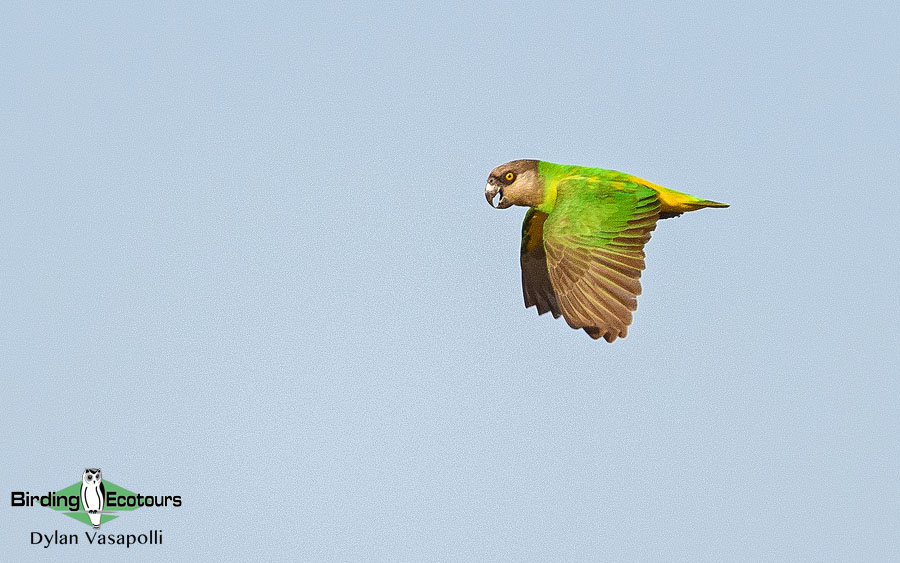
Senegal Parrots were conspicuous in the wooded areas in the southern parts of the country.
We resumed our birding later in the afternoon, once things had begun to cool down. Things were quiet initially, but gradually picked up and we enjoyed a fine spell of birding once more to cap off a great day. A fine Klaas’s Cuckoo kicked things off, before we lucked into a Vieillot’s Barbet perched in the open that gave us great views! As we carried on, we added the likes of African Grey Hornbill, Purple Roller, African Golden Oriole, Glossy-backed Drongo and the massive Long-tailed Glossy Starling. We then ran into a bird party that gave us the first of our European migrants. The party was dominated by numbers of Western Olivaceous Warblers and Common Chiffchaffs, but we also eked out a fine Melodious Warbler along with Northern Black Flycatcher and Common Redstart. We also finally got some good views of Beautiful Sunbird and finished our birding with the locally scarce Purple Starling. After dinner, a short owling walk delivered great views of African Scops Owl.
Day 3, 08th December 2022. Transfer to Kaolack, and visiting the Scissor-tailed Kite roost
Our morning started off in familiar turf, as we explored the excellent woodlands around our lodge before breakfast. The birding was good, and we improved on our views of Stone Partridge from yesterday, and added species such as Greater Honeyguide, Yellow-billed Shrike and a stunning Fine-spotted Woodpecker. A Pearl-spotted Owlet also showed well and we got our first views of the noisy Double-spurred Spurfowl. After breakfast, we gathered our things and checked out – bound for Kaolack. We spent a little while looking for Savile’s Bustard at several sites along the way – though none turned up this bird. We instead had to be content with others like Crested Lark, Whinchat and Northern Wheatear. Waterbirds were well represented again, and we also enjoyed several Black Storks frolicking about in some of the wetlands with the numerous Western Reed Herons. Raptors too showed well, and we added the likes of Short-toed Snake Eagle and Dark Chanting Goshawk, while also enjoying repeat views of Red-necked Falcon, amongst others. Thanks to a road closure, it took a little longer than we anticipated to get into Kaolack, where we would check into our fine hotel, on the edge of the estuary, and have lunch.
Following lunch, we headed off towards N’diaffate and the Kousmar Island, where we would spend the late afternoon watching thousands of Scissor-tailed Kites coming in to roost – one of Senegal’s main birding attractions! We started off our afternoon birding the dry thorny scrub around N’diaffate. New birds rolled in thick and fast in this new environment, and we quickly found specials like Chestnut-bellied Starling and Pygmy Sunbird, and some more careful searching also yielded the stunning African Green Bee-eater along with Black-headed Lapwing, Woodchat Shrike, Common Whitethroat, White-billed Buffalo Weaver, African Silverbill and White-rumped Seedeater. We again searched here for Savile’s Bustard, without luck.
We then made our way over to Kousmar Island, which involved taking a boat across the small channel, and then wading through the mud to get to the other side. Once there, we began our wait for the birds, and before long, the first Scissor-tailed Kites started to show really high up in the sky. Before we knew it, thousands of kites had materialized out of nowhere, and began settling into the surrounding trees, coming down in waves and almost crash landing into the trees. It was a thrilling experience, and one we all thoroughly enjoyed watching! During our time here, we also enjoyed several other birds like Senegal Coucal, the scarce African Collared Dove, Shikra, Lesser Kestrel and Lanner Falcon. A Northern White-faced Owl taunted us by calling out of sight nearby and remained unseen. After having had our fill, we waded through the mud and left the island, taking in some of the waterbirds we were familiar with that had gathered for the evening. Just before we reached our hotel at dusk, we found a Greyish Eagle-Owl perched on a roadside pole (well spotted, Alessio!). We then settled in for the evening following a good day out.
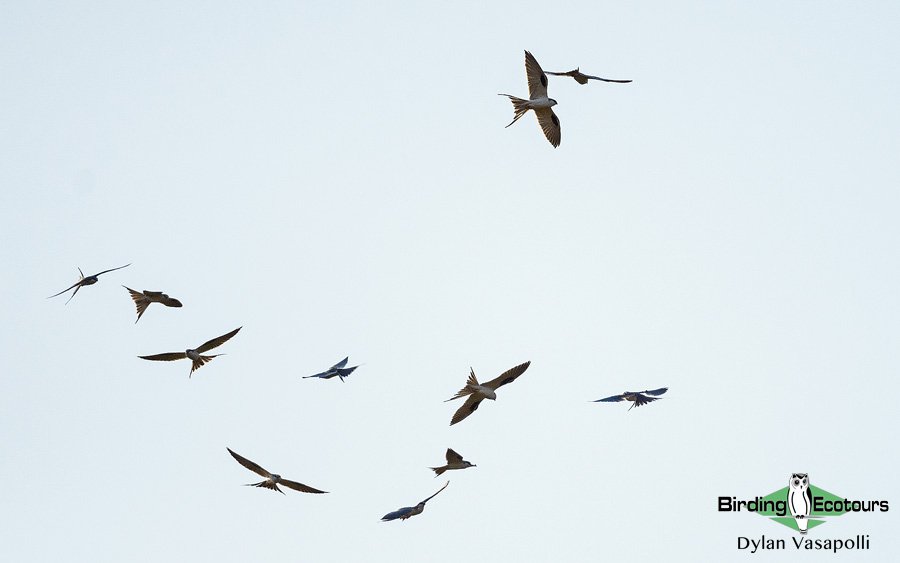
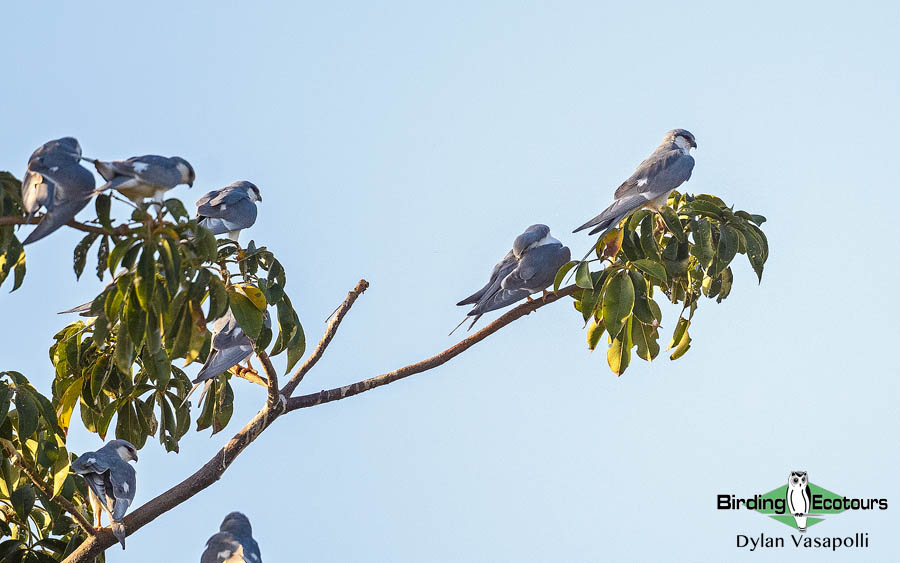
Watching thousands of Scissor-tailed Kites coming in to their roost was very special.
Day 4, 09th December 2022. Searching for Quail-plover
An early start saw us departing the hotel before dawn, in order to reach the site for Quail-plover, some distance away, before it got too warm. Quail-plover is one of the enigmas of the African birding world, occurring sparsely in the Sahel belt, and nowhere common, or predictable. It requires much walking, through harsh desert-like terrain in the hope of flushing or spotting the bird. Covering ground is the name of the game, and it is very much like looking for a needle in a haystack. Senegal, however, has proven to be one of the more reliable sites in recent years, and we hoped to tap into this. We arrived in the cool of the morning, and set out to follow our devised game plan – quite simply walking through the habitat until we saw one. The birds were active and surprisingly diverse despite the harsh and barren terrain, and we saw many different species ranging from Namaqua Doves to Blue-naped Mousebirds and from Black-crowned Tchagras to Chestnut-backed Sparrow-Larks. Great Grey Shrikes perched atop small bushes, fighting for suitable perches with Anteater Chats and Abyssinian Rollers, while Desert Cisticolas danced around them and Black Scrub Robins dashed for cover between them all. Taller trees, which were sparsely spread through the area, yielded the likes of Western Orphean and Western Subalpine Warblers, along with the desirable Sudan Golden Sparrow, Cut-throat Finch and Sahel Paradise Whydah. We also managed to find a few Horsfield’s Bush Larks, an excellent species, but nothing that resembled a Quail-plover. Then, we flushed a bird from behind us, and managed to get onto it, but sadly, it turned out to be a Common Quail. We persisted until the heat was almost unbearable, and on lunch time, we opted to call it a day – returning to our hotel for an afternoon break – having vowed to try again the next day. Some exploring of the saline estuary in front of our hotel gave us Slender-billed Gull, amongst the hordes of more common Black-headed, Grey-headed and Lesser Black-backed Gulls, along with the now familiar suite of waterbirds including various herons, egrets, pelicans and shorebirds.
Day 5, 10th December 2022. Transfer to St Louis, with Quail-plover along the way
Armed with a long drive ahead of us as we transferred to St Louis, along Senegal’s northern coastline, we set off early this morning. We made a slight detour along the way at the Quail-plover fields we had spent the better part of yesterday searching, to have one more go. Taking in our learnings from yesterday, as to where the best habitat was, we headed straight to the area where we thought we would have the best chance, and almost immediately struck gold when we flushed our targeted Quail-plover. We were able to track where the bird went down, and we carefully searched this area, enjoying some brief views of the bird scuttling around with its unique gait, before it flushed once more. Although we would have all enjoyed more prolonged views, we were satisfied, and left the bird in peace, having been successful in our quest for one of Africa’s most highly sought-after, and enigmatic birds! On our way back to the vehicle, we also stumbled onto a Common Buttonquail, which gave us really good views as it walked around. We also enjoyed a similar suite of species to what we had the previous day with Black-headed Lapwing, Abyssinian Roller, Great Grey and Woodchat Shrikes, Horsfield’s Bush Lark, Chestnut-bellied and Greater Blue-eared Starlings, White-billed Buffalo Weaver, Speckle-fronted Weaver and Sudan Golden Sparrow. A shy Eurasian Wryneck was another good find! The rest of the day was spent travelling, with us reaching our lovely beach-side lodge in St Louis in the late afternoon. We did not see too much of interest along the route, bar a flock of Griffon and White-backed Vultures. We settled in for the evening, following our successful quest!
Day 6, 11th December 2022. Transfer to Podor, birding en route and Golden Nigthjar
This was going to be a long day, as we transferred to our most-northerly point in Senegal, the small village of Podor. The primary reason for visiting this small outlying point was to give us a good chance of seeing another highly sought-after bird, Golden Nightjar, which has a small and somewhat difficult-to-access world range. While Golden Nightjar is the primary reason for the visit here, the area is virtually on the edge of Sahara Desert, and several other species are best sought here as well, such as Cricket Warbler and Sennar Penduline Tit, amongst others. We started off our morning birding around the ‘Marigots’ – a series of freshwater pools, surrounded by dry plains and thorn scrub, outside of St Louis. This is the primary site for Savile’s Bustard, and we would spend a few hours searching it out. This was also our first proper exposure to the dry thornveld country of northern Senegal, and we raked in new birds quickly. A bold Senegal Batis called from the treetops, while a pair of Brubrus showed well, and a dainty Yellow-bellied Eremomela also came to investigate us. Migrants were well represented with numerous Common Whitethroats and Common Chiffchaffs present, along with Western Orphean, Western Subalpine and Western Bonelli’s Warblers also present in smaller numbers. After some effort, we also tracked down a group of Orange-breasted Waxbills which showed well, but try as we might, we couldn’t find a bustard. With time against us we pressed on, stopping for a massive flock of Great White Pelicans before having a quick lunch at Richard Toll.
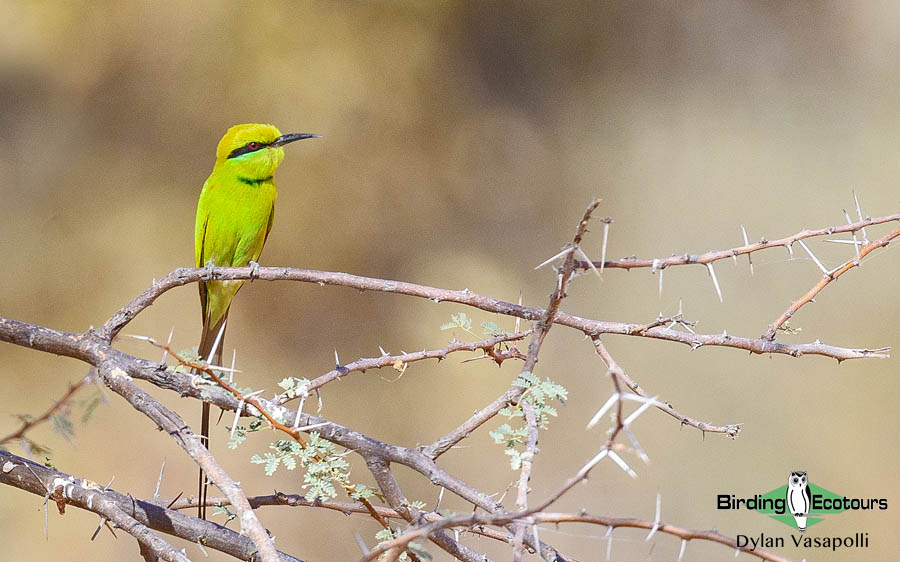
African Green Bee-eaters were a bright addition to the dry scrub.
Following our lunch, we resumed our journey to Podor, exploring a few of the thorny scrub patches hoping for a few of our other target species. However, with the mercury well over 40 degrees Celsius, bird movement was virtually non-existent, though we did find species such as Gabar Goshawk, Blue-naped Mousebird, African Green Bee-eater, Vieillot’s Barbet, Little Weaver and the scarce migrant, Red-throated Pipit. Sadly, our rooms at the lodge were given away to government officials, and it meant we were somewhat in the dark as to our alternative accommodation options. Things worked out well in the end, as we were ushered to a far superior lodge, set in a prime birding area! We had lost a bit of time with all of this, and as soon as we were settled, we resumed our birding by heading for the Diatar Track, where we would be trying for another of Africa’s most sought-after birds, Golden Nightjar. Arriving in the late afternoon, we quickly set off to see if we could find a bird roosting on the ground in the daylight. The surrounding area is filled with various ponds and rivers, and meant there were generally vast numbers of waterbirds moving about. We took in the waterbirds as we searched, but our attempts to find the nightjar were futile. With the area cloaked in darkness now, we changed tactics, and were rewarded with good views of a Long-tailed Nightjar, which also began calling. And then we had our main target, Golden Nightjar, in the torchlight, as it flew around us calling. The bird was a bit flighty, and we were unable to obtain views on the ground as it kept landing in a very dense, bushy area, however content with our excellent and close-up flight views, we left the bird in peace, and all breathed a huge sigh of relief. We settled in for the evening, enjoying a good meal and a cold beer, after a long and successful day.
Day 7, 12th December 2022. Birding Podor and transfer to Djoudj National Park
Our early morning was spent exploring the area around our excellent lodge, which had a network of bird photography hides. The few folks who were up early were also aptly rewarded with an excellent Golden Nightjar, which began their day with a bang! Bright Sudan Golden Sparrows dominated the birds coming down to the various bird hides, and while we waited, we also picked up Western Red-billed Hornbill, Long-tailed Glossy Starling, Black Scrub Robin, Speckle-fronted Weaver, African Silverbill, Vitelline Masked and Black-headed Weavers, Red-cheeked Cordon-bleu and Red-billed Firefinch. The thorny scrub around the lodge was heaving with birds, and we also enjoyed the likes of Mourning Collared Dove, Senegal Thick-knee, Abyssinian Roller, African Green Bee-eater, Vieillot’s Barbet, Yellow-crowned Gonolek, Chestnut-bellied Starling, Common Redstart and another Red-throated Pipit. After breakfast, we bid this incredible birding lodge farewell, heading into the surrounding area.
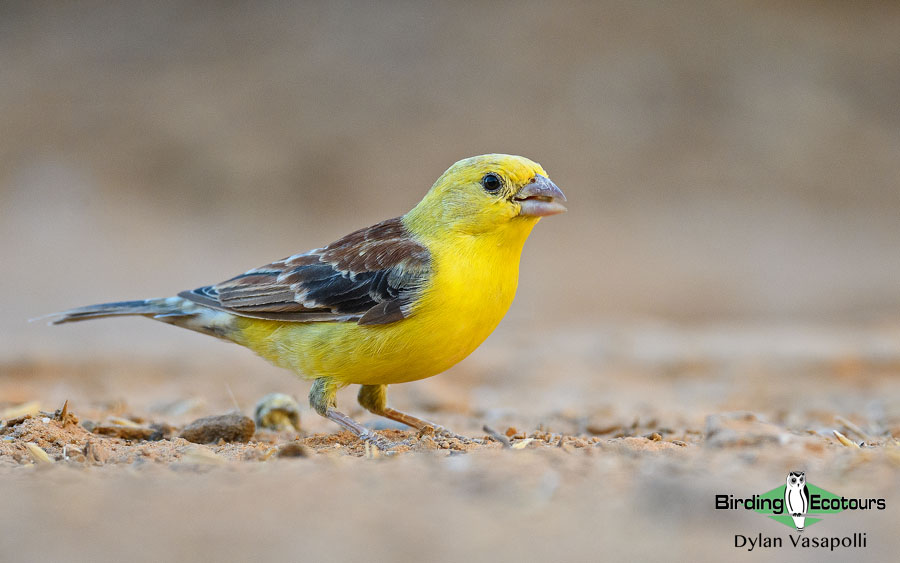
A bright male Sudan Golden Sparrow perches close to one of the bird hides.
Well aware of what the heat could be like in the exposed dunes later on, we focused on that habitat first, and our main target, Cricket Warbler. It proved to be the right choice, as within minutes of walking out into the dunes, we picked up on a calling Cricket Warbler, and were reveling in excellent views a short while later. A large flock of Black-crowned Sparrow-Larks was present in the area as well, and we notched up further views of Yellow-bellied Eremomela and a few pairs of Cut-throat Finch. Moving into the nearby tall acacia woodland, which was a welcomed relief from the already hot sun, we couldn’t have kicked things off any better than by finding a pair of Northern White-faced Owls, virtually immediately after we stepped out of the car. One of our outstanding major targets for this area, Little Grey Woodpecker, was found early on and put on a good show. A vocal Black Scimitarbill sang from the treetops while bright Abyssinian Rollers and African Green Bee-eaters dashed around us. We enjoyed a good spell of birding with several of our now familiar migrant warblers being seen, along with various doves, starlings, sunbirds and seedeaters, but try as we might, we couldn’t locate any Sennar Penduline Tits, our last major target for the area. A quick stop in at the nearby village of Gamadji Sare gave us the hoped-for Horus Swifts – which breed in the riverbanks here, despite being well out of their previously known range. We slowly started working our way back towards Richard Toll, and eventually the Djoudj National Park area where we would be overnighting, exploring a few spots for our still-missing penduline tits. As it so often happens, we had arrived at our last possible stop for this species, and after having explored the area, and all but given up, we lucked into a small group of the very scarce and sought-after Sennar Penduline Tits feeding from virtually above the car.
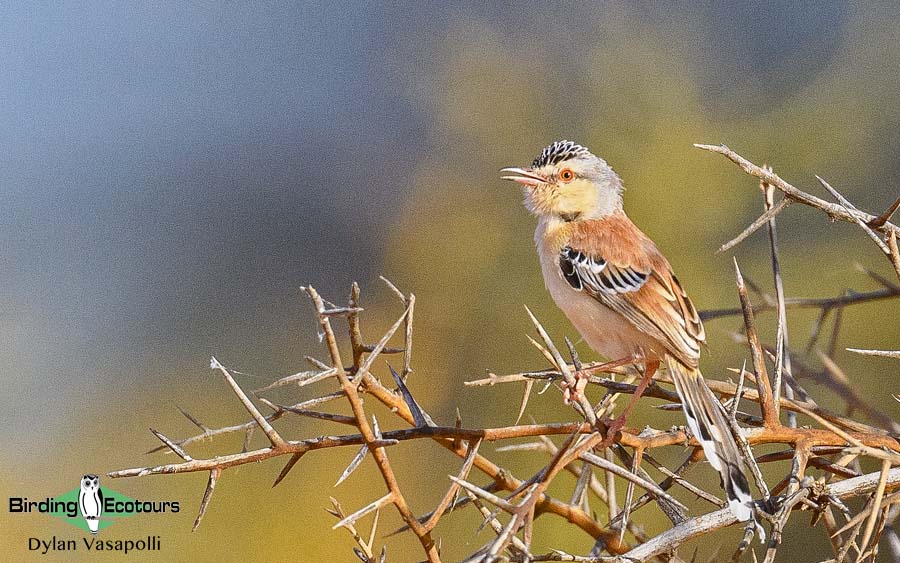
Cricket Warbler is a major target on this tour, and put on a fine show for us.
After another quick lunch, we set off for the Djoudj area, arriving in the mid-afternoon. The Djoudj National Park is made famous by its vast wetlands and lakes, which houses mind-blowingly high numbers of migrant waterfowl – various ducks and shorebirds number into the tens of thousands. Additionally, having such vast wetlands in this otherwise very dry landscape also attracts birds from all over, and quite simply, a great deal of birds abound. A few stops on our way in at some of the outlying water bodies gave us our first sampling of what was to come. Small numbers of shorebirds were present, along with others like Black and Yellow-billed Storks, numbers of Western Marsh Harriers, along with several of jewel-like Malachite Kingfishers.
We checked into our accommodations, and set off for our afternoon birding around the entrance of the park. The lake was just inundated with birds, with the numbers of White-faced Whistling Ducks numbering into the tens of thousands. When the flock lifted, the sky blackened with their wheezy calls filling the air – a truly special sight to behold. Both Greater and Lesser Flamingo were present as were Great White and Pink-backed Pelicans and African and Eurasian Spoonbills – giving us all excellent comparative views. Shorebirds were well represented, with stand-out sightings going to the likes of the many Black-tailed Godwits present, along with smaller numbers of Dunlin, Little Stint and Kittlitz’s Plovers. Some careful scanning of the reedy verges yielded a few sought-after Greater Painted-snipe, along with a shy Little Bittern and a showier Sedge Warbler. A Western Yellow Wagtail patrolled the edges, while both Gull-billed and Whiskered Terns were seen cruising over the deeper parts of the lake. Several Black Crowned Cranes flying over the horizon with the sun setting behind them, rounded off another very successful, but long day of birding with our highest daily total of the trip – just shy of 120 species.
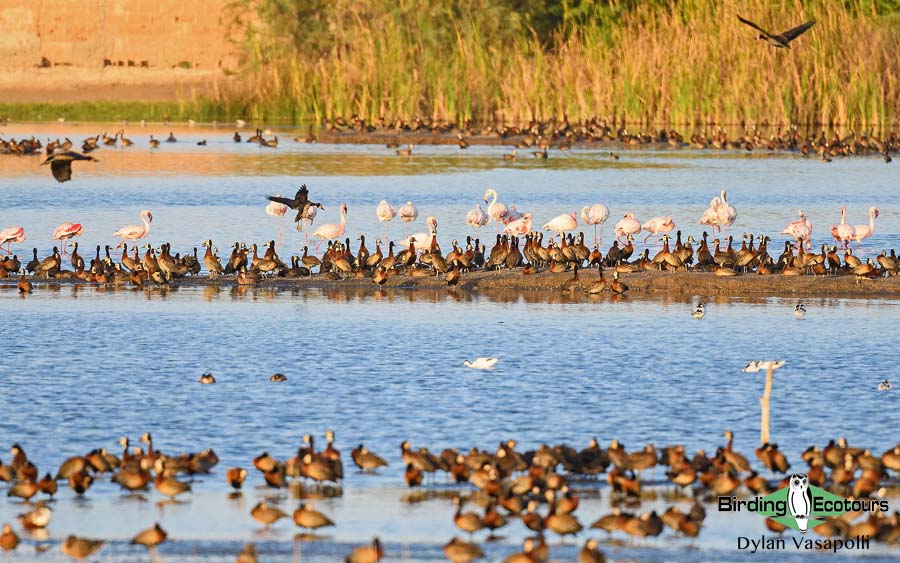
The Djoudj wetlands team with birds during the winter period. Here White-faced Whistling Ducks dominate the numbers in this photo, with smaller numbers of Greater and Lesser Flamingos and Pied Avocets also present.
Day 8, 13th December 2022. Birding Djoudj National Park
We would be spending the day in and around the Djoudj National Park, and set off early to maximize our time outside in the cool of the morning before the overpowering heat kicked in. We enjoyed the masses of birds around the entrance lake briefly on the way in – with the vast numbers of White-faced Whistling Ducks flying about making some spectacle. Smaller marshy areas nearby held a surprising number of Greater Painted-snipes – nearly 20! – and gave us a few other warblers including Common Reed Warbler, Greater Swamp Warbler and a singing Savi’s Warbler. Winding Cisticola was common, and we soon found the prized River Prinia here as well! As we progressed deeper into the park, we enjoyed far better views of Black Crowned Crane than what we had experienced the previous evening, with several close flybys and perched views. Another of our major targets here was the very scarce Arabian Bustard, and once we entered to the drier plains section of the park, we began our search. We kept at it regularly, as we transitioned through these dry sections of the park. A stop at the massive Grande Lac was a welcomed relief from the bustard scanning. Sadly, by the time we had reached the lake, it was already late morning with the sun almost unbearable and the wind swirling dust all around. The bulk of the birds were deep out on the water, yet we could still discern many thousands of Northern Pintails, Northern Shovelers and tens of thousands of Garganeys. Vast numbers of Greater and Lesser Flamingo were also present. Numbers of Ospreys worked the shoreline, as did a Short-toed Snake Eagle, while both Pied and Malachite Kingfishers were present over the water as well. Little Bee-eaters took a liking to the surrounding vegetation and were a regular sight, as were migrant Blue-cheeked Bee-eaters. A Western Barn Owl roosting in one of the bird hides was an interesting sight. Our return through the park, as we headed back to our lodge for an afternoon break, again failed to produce the scarce Arabian Bustard.
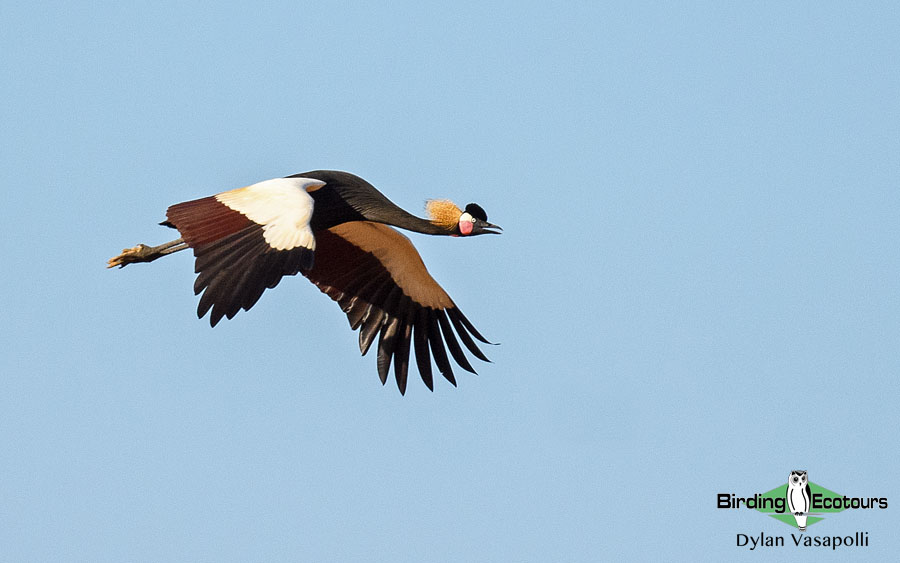
Black Crowned Cranes are a regular feature of the Djoudj wetlands.
Following a breather from the sun, wind and dust, we spent our late afternoon soaking up the incredible waterbird spectacle from the park entrance area once more. In addition to our now familiar suite of waterbirds that were present, which included our estimate of some 50,000 White-faced Whistling Ducks, we added Fulvous Whistling Duck, Kentish Plover, Ruff and Intermediate Egret. Arguably even more impressive than the whistling ducks, was the continuous stream of Red-billed Queleas passing by – for nigh on 25minutes. But not just single birds, vast flocks that cast a shadow, with a very rough guestimate of the number being more than ten million birds! The importance of this national park is highlighted not only by the vast diversity of waterbirds present here, but by the incredibly high numbers of birds utilizing the area, and we felt privileged to have been able to experience this spectacle.
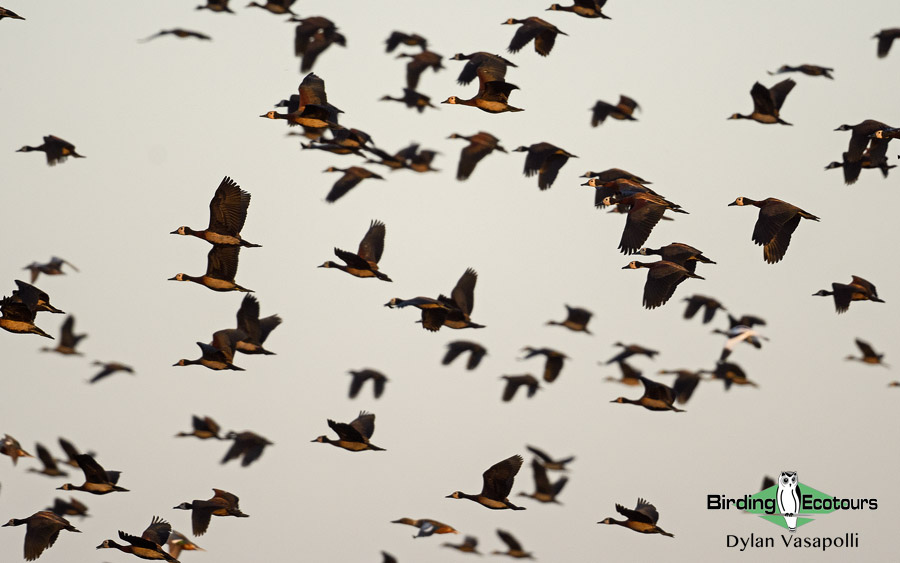
Seeing the incredible numbers of White-faced Whistling Ducks in the Djoudj wetlands left a lasting impression on all of us.
Day 9, 14th December 2022. Travel to Kaolack, birding en route
Today was set aside as a travel day, as we began the long two-day journey to get to the very east of Senegal and the Niokolo-Koba National Park. We would transit roughly half the distance today, to Kaolack, where we were earlier in the trip. We set off early in the morning, enjoying a few stops for various waterbirds as we worked our way out of the Djoudj National Park area. Savile’s Bustard had given us the run-around on all our previous attempts, and we had a final go at the main Marigots site near St Louis. We didn’t have the luxury of time, and were only able to spend an hour or so birding the area. Unfortunately, it wasn’t to be and we couldn’t turn anything we saw into our bustard target. A group of Chestnut-bellied Sandgrouse was a welcomed sight, while several River Prinias were also conspicuously working the area, and the large Great Reed Warbler was added to our list. Dry-country birds like Senegal Batis, Black-crowned Tchagra and Chestnut-bellied Starling were all enjoyed, as were numbers of Orange-breasted Waxbills and Western Yellow Wagtails. Just as we were getting ready to go, a pair of African Fish Eagles gave us a good show. The rest of the day was spent travelling, with little else of interest being seen. We arrived in Kaolack as the sun set, and just in time to see France advance through to the FIFA World Cup final, much to the delight of the Senegalese.
Day 10, 15th December 2022. Transfer to the Niokolo-Koba National Park
Another transfer day lay ahead, with us completing the long journey to get to the Niokolo-Koba National Park. We set off early, making good progress to Tambancounda. Roadside stops gave us a few new birds such as Little Grebe and Hooded Vulture, along with others like Sahel Paradise Whydah and Chestnut-backed Sparrow-Lark. As we neared the park, the vegetation started changing, and we entered the typical Guinea savannah woodlands, that exist in this more wooded portion of the country. Here we said goodbye to our faithful bus for a short while, as we loaded up on our open game viewing vehicle, and made our way into the park. It was still a fairly long way to go in the park until we reached our camp, and we kept our stops to a minimum. A fine Bateleur perched next to the road warranted a stop, as did a pair of delightful Four-banded Sandgrouse. We arrived at our camp in the late afternoon, set on the banks of the Gambia River, where we would spend the next two nights. Some late afternoon birding around the camp was superb as it gave us our first Egyptian Plover feeding on the sandbar opposite the camp, along with a few of the scarce White-crowned Lapwing.
Day 11, 16th December 2022. Birding the Niokolo-Koba National Park
We awoke to a surprisingly chilly morning – so much so that we were all scrabbling for extra clothes, and set off on a short birding walk around the camp. Activity was good, and we quickly got onto our hoped-for Violet Turacos, which showed well. We also saw various other more common and widespread woodland species such as Green Wood Hoopoe, Yellow-fronted Tinkerbird, Cardinal Woodpecker, Yellow-billed Shrike and Long-tailed Glossy Starling. After a quick breakfast, and some coffee to warm ourselves up, we headed off on our morning game drive. Early stops gave us our first Red-throated Bee-eater and White-crested Helmetshrike, before we finally got some excellent views of the stunning Blue-bellied Roller (we had seen birds previously on the tour, but always very poorly). We headed out to a vast open grassy area, which gave us our first large mammals for the park – namely Waterbuck, Kob and African Buffalo. We also picked up the likes of Singing and Short-winged Cisticolas, and Black-winged Bishops here.
A trip to another research camp on the Gambia River produced far better views of the prized Egyptian Plover for us. Here a pair of these birds were engaging in some territorial action with several Spur-winged Lapwings. We also managed to pick up the scarce Adamawa Turtle Dove flying across the river, while scanning its banks gave us our first Grey-headed Kingfisher, and we improved our views of Red-throated Bee-eater. Moving away from the river into the surrounding woodlands, these early highlights were followed up by a few large bird parties. Here, we picked up African Golden Oriole, Senegal Batis, Northern Puffback, African Paradise Flycatcher, Northern Crombec, numbers of the dainty Senegal Eremomela, Willow Warbler, Northern Yellow White-eye, Brown Babbler, European Pied Flycatcher and Sahel Bush Sparrow, as a flood of new birds onto our trip list. With the heat increasing dramatically, we headed for another camp in the park, and explored the dense riverine thickets there. Here we did well to find Brown-throated Wattle-eye and African Blue Flycatcher lurking in the thickets. The raptors were also out and about by now, and we enjoyed seeing species such as African Harrier-Hawk, Bateleur, Long-crested Eagle, Beaudouin’s Snake Eagle, Lizard Buzzard, Red-chested Goshawk, Shikra and African Fish Eagle, all moving about. We then retired back to our camp for lunch and an afternoon rest.
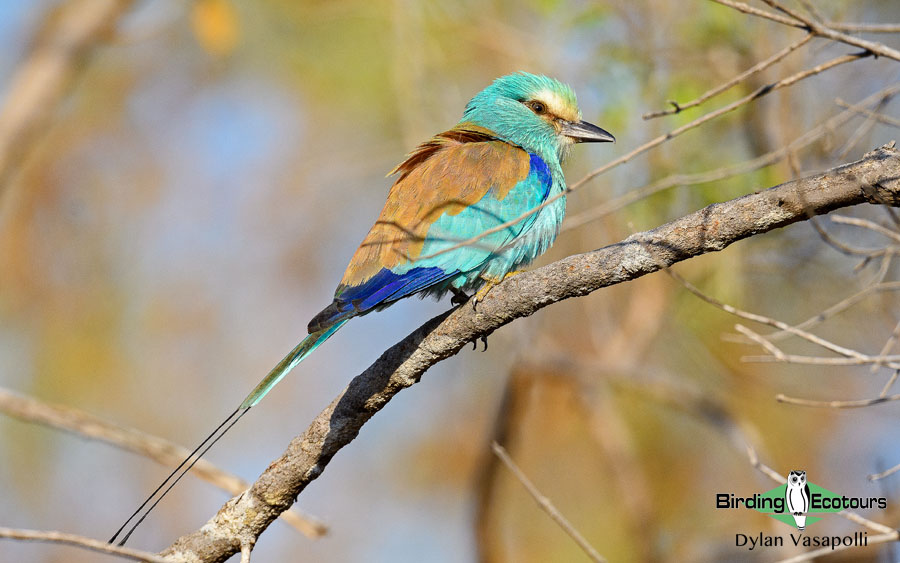
Abyssinian Rollers were always a firm favorite with the group – and it’s not hard to see why!
We explored the area around our camp again the afternoon, but the birding was on the quieter side. A Pearl-spotted Owlet was picked up, as was a fine Red-shouldered Cuckooshrike while the riverine vegetation gave up a stunning Blue-breasted Kingfisher. Then, some incredible excitement followed as a Lion began roaring from very nearby, and a short while later, the Lion was spotted on the opposite side of the river. We enjoyed good, scope view of this incredibly rare mammal in Senegal. To put this in perspective, it was the first sighting of this cat for the entire camp, which also has a large research contingent that are permanently based there. The global cat conservation organization, Panthera, have been monitoring Lions in the park since the early 2010s, and there are only a handful of documented camera trap sightings – let alone actual real-life views! They currently estimate the total Lion population of the park to be between 20-30 individuals. Perhaps of even more significance is the genetic differentiation that these ‘West African’ Lions show to the more widespread ‘African’ Lions. Indeed, these ‘West African’ Lions have been decimated almost to the point of extinction, and researchers estimate the total world population of this subspecies to be under 200 individuals. We would count ourselves extremely fortunate being able to see one of the last ‘West African’ Lions, with very few other people having been privy to this sighting. Still reeling from our incredibly fortunate chance encounter with the Lion, we settled in for the evening and another good meal. A short night-walk followed, but was quiet on the bird side of things, but did give us a fine African Civet wandering around the camp.
Day 12, 17th December 2022. Birding Niokolo-Koba National Park, and transfer to Wassadou Camp
We had a short transfer today, as we left behind the wild Niokolo-Koba National Park, and transferred to the famous (at least amongst birders) Wassadou Camp, which is a little further downstream on the Gambia River. We didn’t have to rush much today, and thus took a morning birding walk around camp to start the morning. We improved on our views of Violet Turaco and Pearl-spotted Owlet, and enjoyed many other species we had seen previously as well, ranging from the massive Bearded Barbet to the elegant Fine-spotted Woodpecker. A Shining-blue Kingfisher dashed along the river, and a lucky few managed to see a Saddle-billed Stork flying overhead. After breakfast, we gathered our things, and loaded up, for a final drive through the park and out towards the entrance gate, where our trusty bus and driver would be waiting. Although the best part of the morning was over, we had a few productive stops picking up a large flock of Bruce’s Green Pigeon, along with the scarce Yellow-bellied Hyliota. We improved on our views of Senegal Eremomela and also found a few Lesser Blue-eared Starlings, before we bumped into a lovely Abyssinian Ground Hornbill walking along the track. Her partner was a little further up the road, and they had a younger bird in tow as well. We thoroughly enjoyed our sighting before they melted away into the dense Guinea savanna woods. As is so typical with birding, we then ran into another group of three Abyssinian Ground Hornbills a short while later. Content and satisfied, we bade farewell to this incredible park.
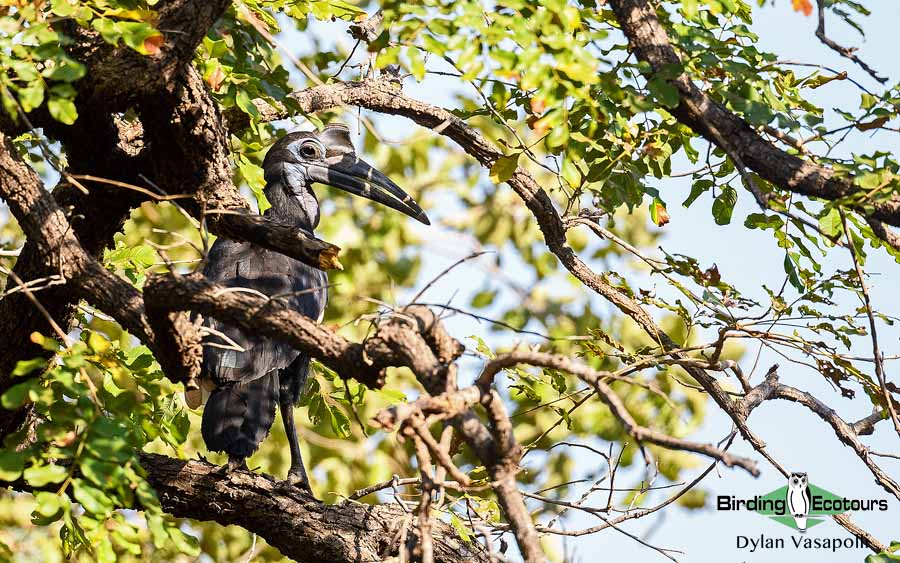
Abyssinian Ground Hornbills were a target bird for the Niokolo-Koba National Park, and several groups showed well in the end.
We only had a short distance to travel, and stopped at an agricultural burn to see what birds were around. As expected, large numbers of the strange Grasshopper Buzzard were dotted all around, waiting for critters escaping the fire. The air above was also filled with birds, and we reveled in our first Northern Carmine Bee-eaters, though the bulk of the numbers were made up of Common Swifts. Careful scanning through the many Common Swifts also gave us several Pallid Swifts, along with the likes of Mottled Spinetail which we had seen previously on the tour. We checked in at Wasadou Camp, had a delightful lunch, and took a short break in the heat of the day. Later in the afternoon, we reconvened for our much-anticipated boat trip on the Gambia River.
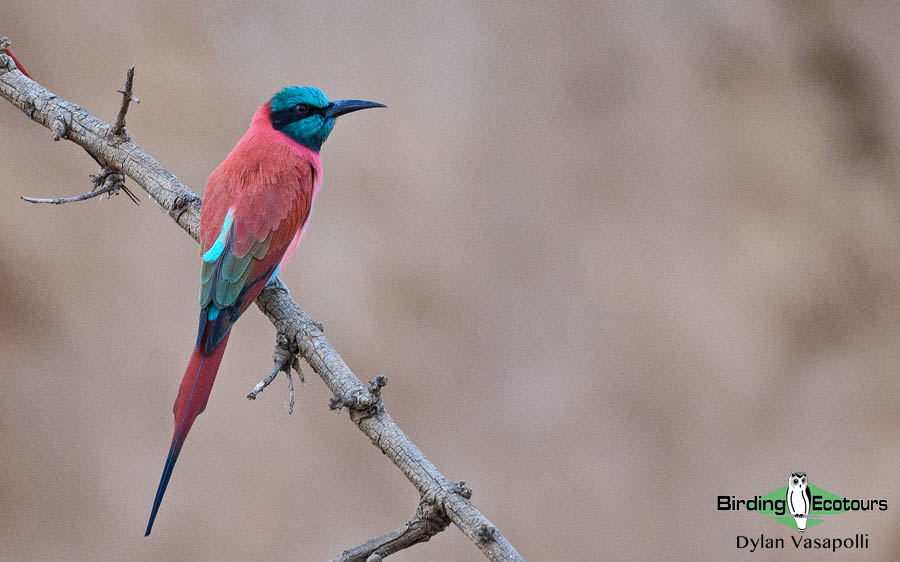
Northern Carmine Bee-eaters are always a delight to see.
The trip started off well, with our main target, Egyptian Plover,showing exceptionally well. While we had seen this bird over the past few days in the Niokolo-Koba National Park, there were no photographic opportunities possible due to the distance of all the sightings. This species is one of the most sought-after shorebirds in Africa, given its status of being monotypic and the sole member of its family. Its looks aren’t all that bad either! After we’d had our fill of the Egyptian Plovers, we focused on some of the other birds around, spending time with large numbers of both Red-throated and Northern Carmine Bee-eaters, along with a vast array of kingfishers – Pied, Giant, Malachite, Woodland, Grey-headed and Blue-breasted Kingfishers all showing well. We also spent a while tracking down the shy White-backed Night Heron, in addition to the much more common and widespread Black-crowned Night Heron. Adamawa Turtle Dove is another important bird of the area, and we far improved on our views here, compared with what we managed in the park the previous day. Raptors were also present along the river, and we notched up African Fish Eagle, Osprey, African Harrier-Hawk, Wahlberg’s Eagle and African Hawk-Eagle. Bronze-tailed Starling, Swamp Flycatcher and Blackcap Babbler were all further new birds. We also enjoyed a close-up sighting of a Hippopotamus, but the shy African Finfoot and rare Pel’s Fishing Owls were nowhere to be found. We settled in for the evening, following another good day out in the field.
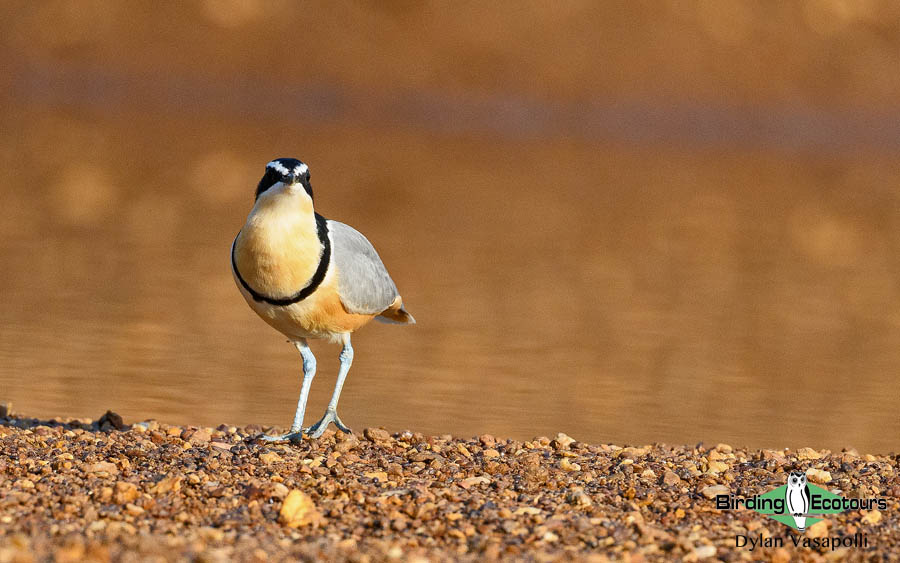
The highly sought-after Egyptian Plover posed well in the beautiful golden afternoon light.
Day 13, 18th December 2022. Birding Wassadou Camp, and transfer to Gambia
Armed with another long drive and a border crossing, we were up early and explored the woods surrounding the camp in the morning for a short while. It was a birdy morning, with lots of our regular species all present. We did well to add the large White-crowned Robin-Chat to our list which showed superbly, and enjoyed the likes of Brown-throated Wattle-eye, Senegal Eremomela, Singing Cisticola and Blackcap Babbler once more. Oriole Warbler played hide-and-seek with us, and ended up winning – despite our best efforts at trying to lure it out of its dark thickets.
After loading up, we settled in for the drive as we made our way to the Senegal-Gambia border, from where we would leave this wonderfully birdy country behind. A few stops were made along the way for several raptors, with the standout species being Dark Chanting Goshawk. West African Swallows greeted us at the border, and after the expected delays and inconveniences, we found ourselves having lunch in Basse, in the Gambia. The high level of water in the river meant the usual Egyptian Plovers were nowhere to be seen. As we journeyed to Janjanbureh, also known as MacCarthy Island, we made a few stops along the way, and rapidly built our Gambia list with additions like Red-throated Bee-eater, Abyssinian Roller, Bearded Barbet, Chestnut-backed Sparrow-Lark, Long-tailed Glossy Starling, Cut-throat Finch and Sahel Bush Sparrow, amongst others. We found ourselves on the island in the late afternoon, and did a short bit of birding in the area. African Green Pigeons sat in the exposed branches at the tops of the trees, while a pair of Red-necked Falcons hunted over some open agricultural lands giving us superb views! We saw a wide range of other birds including Fine-spotted Woodpecker, Yellow-billed Oxpecker, White-crowned Robin-Chat and Lavender Waxbill, before calling it a day. We enjoyed watching the sunset over the Gambia River one last time. A night walk after dinner was excellent, with many Long-tailed Nightjars all showing extremely well.
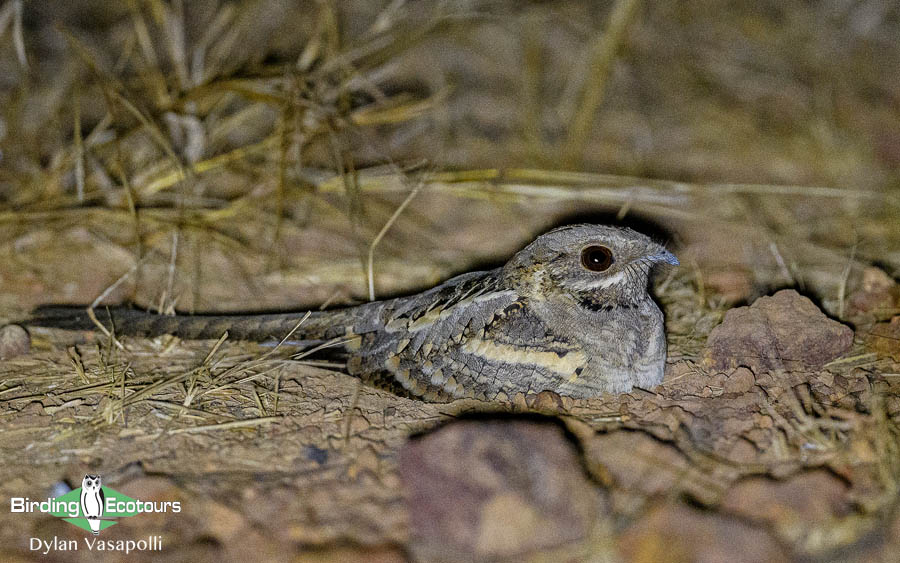
Point-blank views of multiple Long-tailed Nightjars rounded up the day.
Day 14, 19th December 2022. Transfer to Banjul, birding en route
This was our last full day of the tour, as we covered almost the entirety of the Gambia (showing just how small a country it is), bound for the capital, Banjul, where the tour would conclude. Favorites such as Yellow-crowned Gonolek and Beautiful Sunbird started proceedings as we hit the road. A number of stops were made, as we searched for various birds we had yet to see. A pair of Abyssinian Ground Hornbills were a surprising sighting as we went along, and raptors were out in force, as we enjoyed great sightings of Brown Snake Eagle, Western Banded Snake Eagle, Martial Eagle and Lanner Falcon, along with other species we had seen previously on the tour including African Harrier-Hawk, African Hawk-Eagle, Dark Chanting Goshawk, Grasshopper Buzzard, Grey Kestrel and Red-necked Falcon. Bright African Green Bee-eaters flitted about in the wooded areas and Bruce’s Green Pigeons dashed between the trees, while some lily-covered ponds gave us our first African Pygmy Goose. We managed to finally eke out an Oriole Warbler at our last chance, while our views of Red-tailed Leaflove left us wanting a bit more. We rolled into Banjul and checked into our hotel in good time, and settled in for our final dinner, thinking back to all the great birds we had experienced on this tour. The first of the departures began this evening following dinner.
Day 15, 20th December 2022. Birding Abuko Nature Reserve, and departure
This was the departure day, but with the rest of the group only departing later in the day and into the evening, this gave us the full morning to spend birding nearby, and we opted for the Abuko Nature Reserve. This wonderfully forested reserve, located just a stone’s throw away from the airport, is an urban refuge and provides access to some tricky species. Foremost of these is Western Bluebill, and it would be our main target. We began things off with a Red-bellied Paradise Flycatcher, and a few Olive-naped Weavers. A short while later, a faint whistle gave away the presence of a Western Bluebill, but it took us a little while to track it down. Our patience was rewarded with great views, as the bird hopped into the pathway, and gave us incredible views, albeit briefly. We spent some time with the bird, and enjoyed our views as it moved between thickets, feeding out in the open for brief periods of time. A pair of loud Oriole Warblers were nearby, and we had some great looks at these birds too. As we went along, we successfully managed to track down Guinea Turaco and Yellow-breasted Apalis, while a few Fanti Saw-wings flicked about overhead, while a Buff-spotted Woodpecker didn’t hang around for long. Some flowers attracted several dapper Copper Sunbirds, while a large feeding group of Lavender Waxbills rounded off our time birding the reserve, and for the trip. The rest of the group departed in the evening.
I would like to thank all the participants who joined this set departure birding tour and for contributing to making this tour the success it was.
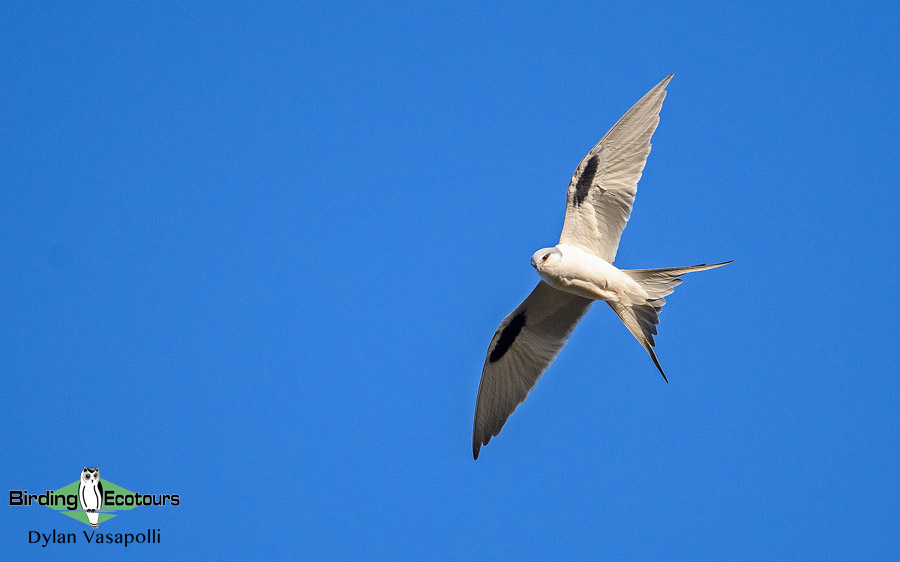
The incredible Scissor-tailed Kite roost, where we watched thousands of these birds settling in for the evening, was a special moment for all of us!
Without further ado, here are the top birds on the trip, as voted for by the participants:
- Egyptian Plover
- Northern Carmine Bee-eater
- Scissor-tailed Kite
- Golden Nightjar
- Cricket Warbler
- Martial Eagle
Some honorable mentions go to:
- Abyssinian Roller
- Swallow-tailed Bee-eater
- River Prinia
- Abyssinian Ground Hornbill
- White-crested Tiger Heron
- Black Crowned Crane
Bird List – Following IOC 12.2
Birds ‘heard only’ are marked with (H) after the common name, all other species were seen.
The following notation after species names is used to show conservation status following the IUCN Red List:
CR = Critically Endangered, EN = Endangered, VU = Vulnerable, NT = Near Threatened.
| Common name | Scientific name |
| Ducks, Geese, Swans (Anatidae) | |
| White-faced Whistling Duck | Dendrocygna viduata |
| Fulvous Whistling Duck | Dendrocygna bicolor |
| Spur-winged Goose | Plectropterus gambensis |
| Knob-billed Duck | Sarkidiornis melanotos |
| Egyptian Goose | Alopochen aegyptiaca |
| African Pygmy Goose | Nettapus auritus |
| Garganey | Spatula querquedula |
| Northern Shoveler | Spatula clypeata |
| Northern Pintail | Anas acuta |
| Guineafowl (Numididae) | |
| Helmeted Guineafowl | Numida meleagris |
| New World Quail (Odontophoridae) | |
| Stone Partridge | Ptilopachus petrosus |
| Pheasants & Allies (Phasianidae) | |
| Common Quail | Coturnix coturnix |
| Double-spurred Spurfowl | Pternistis bicalcaratus |
| Nightjars (Caprimulgidae) | |
| Golden Nightjar | Caprimulgus eximius |
| Long-tailed Nightjar | Caprimulgus climacurus |
| Swifts (Apodidae) | |
| Mottled Spinetail | Telacanthura ussheri |
| African Palm Swift | Cypsiurus parvus |
| Common Swift | Apus apus |
| Pallid Swift | Apus pallidus |
| Little Swift | Apus affinis |
| Horus Swift | Apus horus |
| Turacos (Musophagidae) | |
| Western Plantain-eater | Crinifer piscator |
| Violet Turaco | Tauraco violaceus |
| Guinea Turaco | Tauraco persa |
| Cuckoos (Cuculidae) | |
| Senegal Coucal | Centropus senegalensis |
| Levaillant’s Cuckoo | Clamator levaillantii |
| Klaas’s Cuckoo | Chrysococcyx klaas |
| Sandgrouse (Pteroclidae) | |
| Chestnut-bellied Sandgrouse | Pterocles exustus |
| Four-banded Sandgrouse | Pterocles quadricinctus |
| Pigeons, Doves (Columbidae) | |
| Rock Dove | Columba livia |
| Speckled Pigeon | Columba guinea |
| Adamawa Turtle Dove | Streptopelia hypopyrrha |
| African Collared Dove | Streptopelia roseogrisea |
| Mourning Collared Dove | Streptopelia decipiens |
| Red-eyed Dove | Streptopelia semitorquata |
| Vinaceous Dove | Streptopelia vinacea |
| Laughing Dove | Spilopelia senegalensis |
| Black-billed Wood Dove | Turtur abyssinicus |
| Namaqua Dove | Oena capensis |
| Bruce’s Green Pigeon | Treron waalia |
| African Green Pigeon | Treron calvus |
| Rails, Crakes & Coots (Rallidae) | |
| Common Moorhen | Gallinula chloropus |
| Black Crake | Zapornia flavirostra |
| Cranes (Gruidae) | |
| Black Crowned Crane – VU | Balearica pavonina |
| Grebes (Podicipedidae) | |
| Little Grebe | Tachybaptus ruficollis |
| Flamingos (Phoenicopteridae) | |
| Greater Flamingo | Phoenicopterus roseus |
| Lesser Flamingo | Phoeniconaias minor |
| Buttonquail (Turnicidae) | |
| Common Buttonquail | Turnix sylvaticus |
| Quail-plover | Ortyxelos meiffrenii |
| Stone-curlews, Thick-knees (Burhinidae) | |
| Senegal Thick-knee | Burhinus senegalensis |
| Spotted Thick-knee | Burhinus capensis |
| Stilts, Avocets (Recurvirostridae) | |
| Black-winged Stilt | Himantopus himantopus |
| Pied Avocet | Recurvirostra avosetta |
| Plovers (Charadriidae) | |
| Spur-winged Lapwing | Vanellus spinosus |
| Black-headed Lapwing | Vanellus tectus |
| White-crowned Lapwing | Vanellus albiceps |
| African Wattled Lapwing | Vanellus senegallus |
| Grey Plover | Pluvialis squatarola |
| Common Ringed Plover | Charadrius hiaticula |
| Little Ringed Plover | Charadrius dubius |
| Kittlitz’s Plover | Charadrius pecuarius |
| Kentish Plover | Charadrius alexandrinus |
| Egyptian Plover (Pluvianidae) | |
| Egyptian Plover | Pluvianus aegyptius |
| Painted-snipes (Rostratulidae) | |
| Greater Painted-snipe | Rostratula benghalensis |
| Jacanas (Jacanidae) | |
| African Jacana | Actophilornis africanus |
| Sandpipers, Snipes (Scolopacidae) | |
| Eurasian Whimbrel | Numenius phaeopus |
| Eurasian Curlew | Numenius arquata |
| Bar-tailed Godwit | Limosa lapponica |
| Black-tailed Godwit | Limosa limosa |
| Red Knot | Calidris canutus |
| Ruff | Calidris pugnax |
| Curlew Sandpiper | Calidris ferruginea |
| Sanderling | Calidris alba |
| Dunlin | Calidris alpina |
| Little Stint | Calidris minuta |
| Common Sandpiper | Actitis hypoleucos |
| Green Sandpiper | Tringa ochropus |
| Common Redshank | Tringa totanus |
| Marsh Sandpiper | Tringa stagnatilis |
| Wood Sandpiper | Tringa glareola |
| Common Greenshank | Tringa nebularia |
| Coursers, Pratincoles (Glareolidae) | |
| Temminck’s Courser | Cursorius temminckii |
| Gulls, Terns, Skimmers (Laridae) | |
| Slender-billed Gull | Chroicocephalus genei |
| Black-headed Gull | Chroicocephalus ridibundus |
| Grey-headed Gull | Chroicocephalus cirrocephalus |
| Lesser Black-backed Gull | Larus fuscus |
| Gull-billed Tern | Gelochelidon nilotica |
| Caspian Tern | Hydroprogne caspia |
| West African Crested Tern | Thalasseus albididorsalis |
| Sandwich Tern | Thalasseus sandvicensis |
| Common Tern | Sterna hirundo |
| Whiskered Tern | Chlidonias hybrida |
| Skuas (Stercorariidae) | |
| Pomarine Jaeger | Stercorarius pomarinus |
| Parasitic Jaeger | Stercorarius parasiticus |
| Storks (Ciconiidae) | |
| Yellow-billed Stork | Mycteria ibis |
| Black Stork | Ciconia nigra |
| Saddle-billed Stork | Ephippiorhynchus senegalensis |
| Anhingas, Darters (Anhingidae) | |
| African Darter | Anhinga rufa |
| Cormorants, Shags (Phalacrocoracidae) | |
| Reed Cormorant | Microcarbo africanus |
| White-breasted Cormorant | Phalacrocorax lucidus |
| Ibises, Spoonbills (Threskiornithidae) | |
| African Sacred Ibis | Threskiornis aethiopicus |
| Hadada Ibis | Bostrychia hagedash |
| Glossy Ibis | Plegadis falcinellus |
| Eurasian Spoonbill | Platalea leucorodia |
| African Spoonbill | Platalea alba |
| Herons, Bitterns (Ardeidae) | |
| White-crested Tiger Heron | Tigriornis leucolopha |
| Little Bittern | Ixobrychus minutus |
| White-backed Night Heron | Gorsachius leuconotus |
| Black-crowned Night Heron | Nycticorax nycticorax |
| Striated Heron | Butorides striata |
| Squacco Heron | Ardeola ralloides |
| Western Cattle Egret | Bubulcus ibis |
| Grey Heron | Ardea cinerea |
| Black-headed Heron | Ardea melanocephala |
| Purple Heron | Ardea purpurea |
| Great Egret | Ardea alba |
| Intermediate Egret | Ardea intermedia |
| Black Heron | Egretta ardesiaca |
| Little Egret | Egretta garzetta |
| Western Reef Heron | Egretta gularis |
| Hamerkop (Scopidae) | |
| Hamerkop | Scopus umbretta |
| Pelicans (Pelecanidae) | |
| Great White Pelican | Pelecanus onocrotalus |
| Pink-backed Pelican | Pelecanus rufescens |
| Ospreys (Pandionidae) | |
| Osprey | Pandion haliaetus |
| Kites, Hawks, Eagles (Accipitridae) | |
| Black-winged Kite | Elanus caeruleus |
| Scissor-tailed Kite – VU | Chelictinia riocourii |
| African Harrier-Hawk | Polyboroides typus |
| Palm-nut Vulture | Gypohierax angolensis |
| Hooded Vulture – CR | Necrosyrtes monachus |
| White-backed Vulture – CR | Gyps africanus |
| Griffon Vulture | Gyps fulvus |
| Short-toed Snake Eagle | Circaetus gallicus |
| Beaudouin’s Snake Eagle – VU | Circaetus beaudouini |
| Brown Snake Eagle | Circaetus cinereus |
| Western Banded Snake Eagle | Circaetus cinerascens |
| Bateleur – EN | Terathopius ecaudatus |
| Martial Eagle – EN | Polemaetus bellicosus |
| Long-crested Eagle | Lophaetus occipitalis |
| Wahlberg’s Eagle | Hieraaetus wahlbergi |
| African Hawk-Eagle | Aquila spilogaster |
| Lizard Buzzard | Kaupifalco monogrammicus |
| Gabar Goshawk | Micronisus gabar |
| Dark Chanting Goshawk | Melierax metabates |
| Red-chested Goshawk | Accipiter toussenelii |
| Shikra | Accipiter badius |
| Western Marsh Harrier | Circus aeruginosus |
| Black Kite | Milvus migrans |
| Yellow-billed Kite | Milvus aegyptius |
| African Fish Eagle | Haliaeetus vocifer |
| Grasshopper Buzzard | Butastur rufipennis |
| Barn Owls (Tytonidae) | |
| Western Barn Owl | Tyto alba |
| Owls (Strigidae) | |
| Pearl-spotted Owlet | Glaucidium perlatum |
| African Scops Owl | Otus senegalensis |
| Northern White-faced Owl | Ptilopsis leucotis |
| Greyish Eagle-Owl | Bubo cinerascens |
| Mousebirds (Coliidae) | |
| Blue-naped Mousebird | Urocolius macrourus |
| Hoopoes (Upupidae) | |
| Eurasian Hoopoe | Upupa epops |
| Wood Hoopoes (Phoeniculidae) | |
| Green Wood Hoopoe | Phoeniculus purpureus |
| Black Scimitarbill | Rhinopomastus aterrimus |
| Ground Hornbills (Bucorvidae) | |
| Abyssinian Ground Hornbill – VU | Bucorvus abyssinicus |
| Hornbills (Bucerotidae) | |
| Western Red-billed Hornbill | Tockus kempi |
| African Grey Hornbill | Lophoceros nasutus |
| Rollers (Coraciidae) | |
| Purple Roller | Coracias naevius |
| Abyssinian Roller | Coracias abyssinicus |
| Blue-bellied Roller | Coracias cyanogaster |
| Broad-billed Roller | Eurystomus glaucurus |
| Kingfishers (Alcedinidae) | |
| Grey-headed Kingfisher | Halcyon leucocephala |
| Striped Kingfisher | Halcyon chelicuti |
| Blue-breasted Kingfisher | Halcyon malimbica |
| Woodland Kingfisher | Halcyon senegalensis |
| Malachite Kingfisher | Corythornis cristatus |
| Shining-blue Kingfisher | Alcedo quadribrachys |
| Giant Kingfisher | Megaceryle maxima |
| Pied Kingfisher | Ceryle rudis |
| Bee-eaters (Meropidae) | |
| Swallow-tailed Bee-eater | Merops hirundineus |
| Little Bee-eater | Merops pusillus |
| Red-throated Bee-eater | Merops bulocki |
| African Green Bee-eater | Merops viridissimus |
| Blue-cheeked Bee-eater | Merops persicus |
| European Bee-eater (H) | Merops apiaster |
| Northern Carmine Bee-eater | Merops nubicus |
| African Barbets (Lybiidae) | |
| Yellow-fronted Tinkerbird | Pogoniulus chrysoconus |
| Vieillot’s Barbet | Lybius vieilloti |
| Bearded Barbet | Lybius dubius |
| Honeyguides (Indicatoridae) | |
| Greater Honeyguide | Indicator indicator |
| Woodpeckers (Picidae) | |
| Eurasian Wryneck | Jynx torquilla |
| Buff-spotted Woodpecker | Pardipicus nivosus |
| Fine-spotted Woodpecker | Campethera punctuligera |
| Little Grey Woodpecker | Dendropicos elachus |
| Cardinal Woodpecker (H) | Dendropicos fuscescens |
| African Grey Woodpecker | Dendropicos goertae |
| Caracaras, Falcons (Falconidae) | |
| Lesser Kestrel | Falco naumanni |
| Common Kestrel | Falco tinnunculus |
| Grey Kestrel | Falco ardosiaceus |
| Red-necked Falcon | Falco chicquera |
| Lanner Falcon | Falco biarmicus |
| African & New World Parrots (Psittacidae) | |
| Senegal Parrot | Poicephalus senegalus |
| Old World Parrots (Psittaculidae) | |
| Rose-ringed Parakeet | Psittacula krameri |
| Wattle-eyes, Batises (Platysteiridae) | |
| Senegal Batis | Batis senegalensis |
| Brown-throated Wattle-eye | Platysteira cyanea |
| Bushshrikes (Malaconotidae) | |
| Grey-headed Bushshrike | Malaconotus blanchoti |
| Orange-breasted Bushshrike | Chlorophoneus sulfureopectus |
| Black-crowned Tchagra | Tchagra senegalus |
| Northern Puffback | Dryoscopus gambensis |
| Yellow-crowned Gonolek | Laniarius barbarus |
| Brubru | Nilaus afer |
| Vangas & Allies (Vangidae) | |
| White-crested Helmetshrike | Prionops plumatus |
| Cuckooshrikes (Campephagidae) | |
| Red-shouldered Cuckooshrike | Campephaga phoenicea |
| Shrikes (Laniidae) | |
| Yellow-billed Shrike | Corvinella corvina |
| Great Grey Shrike | Lanius excubitor |
| Woodchat Shrike | Lanius senator |
| Figbirds, Old World Orioles, Piopios (Oriolidae) | |
| African Golden Oriole | Oriolus auratus |
| Drongos (Dicruridae) | |
| Glossy-backed Drongo | Dicrurus divaricatus |
| Monarchs (Monarchidae) | |
| Red-bellied Paradise Flycatcher | Terpsiphone rufiventer |
| African Paradise Flycatcher | Terpsiphone viridis |
| Crows, Jays (Corvidae) | |
| Piapiac | Ptilostomus afer |
| Pied Crow | Corvus albus |
| Fairy Flycatchers (Stenostiridae) | |
| African Blue Flycatcher | Elminia longicauda |
| Penduline Tits (Remizidae) | |
| Sennar Penduline Tit | Anthoscopus punctifrons |
| Larks (Alaudidae) | |
| Black-crowned Sparrow-Lark | Eremopterix nigriceps |
| Chestnut-backed Sparrow-Lark | Eremopterix leucotis |
| Horsfield’s Bush Lark | Mirafra javanica |
| Crested Lark | Galerida cristata |
| Bulbuls (Pycnonotidae) | |
| Little Greenbul | Eurillas virens |
| Red-tailed Leaflove (H) | Phyllastrephus scandens |
| Common Bulbul | Pycnonotus barbatus |
| Swallows, Martins (Hirundinidae) | |
| Fanti Saw-wing | Psalidoprocne obscura |
| Sand Martin | Riparia riparia |
| Wire-tailed Swallow | Hirundo smithii |
| Barn Swallow | Hirundo rustica |
| Red-chested Swallow | Hirundo lucida |
| Common House Martin | Delichon urbicum |
| West African Swallow | Cecropis domicella |
| Crombecs, African Warblers (Macrosphenidae) | |
| Northern Crombec | Sylvietta brachyura |
| Leaf Warblers (Phylloscopidae) | |
| Western Bonelli’s Warbler | Phylloscopus bonelli |
| Willow Warbler | Phylloscopus trochilus |
| Common Chiffchaff | Phylloscopus collybita |
| Reed Warblers & Allies (Acrocephalidae) | |
| Greater Swamp Warbler | Acrocephalus rufescens |
| Great Reed Warbler (H) | Acrocephalus arundinaceus |
| Sedge Warbler | Acrocephalus schoenobaenus |
| Common Reed Warbler | Acrocephalus scirpaceus |
| Western Olivaceous Warbler | Iduna opaca |
| Melodious Warbler | Hippolais polyglotta |
| Grassbirds & Allies (Locustellidae) | |
| Savi’s Warbler (H) | Locustella luscinioides |
| Cisticolas & Allies (Cisticolidae) | |
| Singing Cisticola | Cisticola cantans |
| Winding Cisticola | Cisticola marginatus |
| Short-winged Cisticola | Cisticola brachypterus |
| Zitting Cisticola | Cisticola juncidis |
| Desert Cisticola | Cisticola aridulus |
| Tawny-flanked Prinia | Prinia subflava |
| River Prinia | Prinia fluviatilis |
| Cricket Warbler | Spiloptila clamans |
| Yellow-breasted Apalis | Apalis flavida |
| Oriole Warbler | Hypergerus atriceps |
| Grey-backed Camaroptera | Camaroptera brevicaudata |
| Yellow-bellied Eremomela | Eremomela icteropygialis |
| Senegal Eremomela | Eremomela pusilla |
| Sylviid Babblers (Sylviidae) | |
| Western Orphean Warbler | Curruca hortensis |
| Western Subalpine Warbler | Curruca iberiae |
| Common Whitethroat | Curruca communis |
| White-eyes (Zosteropidae) | |
| Northern Yellow White-eye | Zosterops senegalensis |
| Laughingthrushes & Allies (Leiothrichidae) | |
| Brown Babbler | Turdoides plebejus |
| Blackcap Babbler | Turdoides reinwardtii |
| Hyliotas (Hyliotidae) | |
| Yellow-bellied Hyliota | Hyliota flavigaster |
| Starlings, Rhabdornises (Sturnidae) | |
| Greater Blue-eared Starling | Lamprotornis chalybaeus |
| Lesser Blue-eared Starling | Lamprotornis chloropterus |
| Bronze-tailed Starling | Lamprotornis chalcurus |
| Purple Starling | Lamprotornis purpureus |
| Long-tailed Glossy Starling | Lamprotornis caudatus |
| Chestnut-bellied Starling | Lamprotornis pulcher |
| Oxpeckers (Buphagidae) | |
| Yellow-billed Oxpecker | Buphagus africanus |
| Thrushes (Turdidae) | |
| African Thrush | Turdus pelios |
| Chats, Old World Flycatchers (Muscicapidae) | |
| Black Scrub Robin | Cercotrichas podobe |
| Grey Tit-Flycatcher | Myioparus plumbeus |
| Northern Black Flycatcher | Melaenornis edolioides |
| Swamp Flycatcher | Muscicapa aquatica |
| Snowy-crowned Robin-Chat | Cossypha niveicapilla |
| White-crowned Robin-Chat | Cossypha albicapillus |
| European Pied Flycatcher | Ficedula hypoleuca |
| Common Redstart | Phoenicurus phoenicurus |
| Whinchat | Saxicola rubetra |
| African Stonechat | Saxicola torquatus |
| Anteater Chat | Myrmecocichla aethiops |
| Northern Wheatear | Oenanthe oenanthe |
| Sunbirds (Nectariniidae) | |
| Pygmy Sunbird | Hedydipna platura |
| Scarlet-chested Sunbird | Chalcomitra senegalensis |
| Beautiful Sunbird | Cinnyris pulchellus |
| Variable Sunbird | Cinnyris venustus |
| Copper Sunbird | Cinnyris cupreus |
| Old World Sparrows, Snowfinches (Passeridae) | |
| Sahel Bush Sparrow | Gymnoris dentata |
| Northern Grey-headed Sparrow | Passer griseus |
| House Sparrow | Passer domesticus |
| Sudan Golden Sparrow | Passer luteus |
| Weavers, Widowbirds (Ploceidae) | |
| White-billed Buffalo Weaver | Bubalornis albirostris |
| Speckle-fronted Weaver | Sporopipes frontalis |
| Little Weaver | Ploceus luteolus |
| Black-necked Weaver | Ploceus nigricollis |
| Vitelline Masked Weaver | Ploceus vitellinus |
| Village Weaver | Ploceus cucullatus |
| Black-headed Weaver | Ploceus melanocephalus |
| Red-billed Quelea | Quelea quelea |
| Yellow-crowned Bishop | Euplectes afer |
| Black-winged Red Bishop | Euplectes hordeaceus |
| Northern Red Bishop | Euplectes franciscanus |
| Waxbills, Munias & Allies (Estrildidae) | |
| Bronze Mannikin | Spermestes cucullata |
| African Silverbill | Euodice cantans |
| Lavender Waxbill | Glaucestrilda caerulescens |
| Black-rumped Waxbill | Estrilda troglodytes |
| Cut-throat Finch | Amadina fasciata |
| Orange-breasted Waxbill | Amandava subflava |
| Red-cheeked Cordon-bleu | Uraeginthus bengalus |
| Western Bluebill | Spermophaga haematina |
| Red-billed Firefinch | Lagonosticta senegala |
| Indigobirds, Whydahs (Viduidae) | |
| Village Indigobird | Vidua chalybeata |
| Sahel Paradise Whydah | Vidua orientalis |
| Wagtails, Pipits (Motacillidae) | |
| Western Yellow Wagtail | Motacilla flava |
| White Wagtail | Motacilla alba |
| African Pied Wagtail | Motacilla aguimp |
| Red-throated Pipit | Anthus cervinus |
| Finches, Euphonias (Fringillidae) | |
| White-rumped Seedeater | Crithagra leucopygia |
| Yellow-fronted Canary | Crithagra mozambica |
| Species seen: | 317 |
| Species heard: | 5 |
| Total recorded: | 322 |
Mammal List
Mammals ‘heard only’ are marked with (H) after the common name, all other species were seen.
The following notation after species names is used to show conservation status following the IUCN Red List:
CR = Critically Endangered, EN = Endangered, VU = Vulnerable, NT = Near Threatened.
| Common name | Scientific name |
| Rabbits and Hares (Leporidae) | |
| African Savanna Hare | Lepus victoriae |
| Squirrels and Relatives (Sciuridae) | |
| Striped Ground Squirrel | Euxerus erythropus |
| Gambian Sun Squirrel | Heliosciurus gambianus |
| Old World Monkeys (Cercopithecidae) | |
| Guinea Baboon | Papio papio |
| Common Patas Monkey | Erythrocebus patas |
| Green Monkey | Chlorocebus sabaeus |
| West African Red Colobus – EN | Piliocolobus badius |
| Cats (Felidae) | |
| Lion – VU | Panthera leo |
| Civets, Genets, Linsangs and allies (Viverridae) | |
| African Civet | Civettictis civetta |
| Hyaenas and Aardwolf (Hyaenidae) | |
| Spotted Hyaena (H) | Crocuta crocuta |
| Mongooses and Fossa (Herpestidae) | |
| Marsh Mongoose | Atilax paludinosus |
| Banded Mongoose | Mungos mungo |
| Canids (Canidae) | |
| African Golden Wolf | Canis lupaster |
| Hogs and Pigs (Suidae) | |
| Common Warthog | Phacochoerus africanus |
| Hippopotamuses (Hippopotamidae) | |
| Hippopotamus – VU | Hippopotamus amphibius |
| Bovids (Bovidae) | |
| African Buffalo | Syncerus caffer |
| Western Bushbuck | Tragelaphus scriptus |
| Waterbuck | Kobus ellipsiprymnus |
| Kob | Kobus kob |
| Species seen: | 18 |
| Species heard: | 1 |
| Total recorded: | 19 |
This is a sample trip report. Please email us ([email protected]) for more trip reports from this destination.
